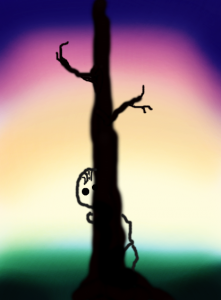 Hey there, happy writer people! Today we’re going to discuss a part of your novel you might not even be aware exists. This elusive element of your writing is called the “hidden story,” and it’s essential to delivering a tale that will keep your readers up way past their bedtimes.
Hey there, happy writer people! Today we’re going to discuss a part of your novel you might not even be aware exists. This elusive element of your writing is called the “hidden story,” and it’s essential to delivering a tale that will keep your readers up way past their bedtimes.
Hide and Seek
Hide
In your story, things happen “onscreen” and “offscreen.” Onscreen, your readers see your main character settling in for a cozy evening, when suddenly a ton of dwarves show up on his doorstep. Onscreen, your readers see your main character frantically trying to contain the situation while the dwarves make short work on his pantry and then get down to the business of plotting a hazardous quest. (If you don’t know what I’m talking about, read this and this.)
Offscreen, a wizard is marking your main character’s front door. Offscreen, a scrawny creature is using a magic ring. Offscreen, a necromancer is amassing his power. Offscreen, a dragon is dreaming.
“Offscreen” is another term for “hidden story”: all the things that happen in your story that the reader doesn’t see. You could also call it the “offstage action”: costume and set changes that move your character along in the plot. The audience doesn’t get to see these things happen, but when the curtain rises again–when you, the writer, bring your characters out before their audience again–your readers see that your characters have moved from one place to another, time has passed, changes have taken place.
Seek
So why is any of that behind-the-scenes stuff necessary? If the reader is never going to see it, then why in heaven’s name should you, busy wordsmith that you are, have to hammer it all out?
Well, y’all, “hidden story” is important because what we’re really talking about here isn’t an extra set of stories behind the scenes. What we’re really talking about is solid structure. Your hidden story anchors your “onscreen” story so it can feel realistic to your reader. Your reader doesn’t need to see all the behind-the-scenes or between-the-scenes stuff. Show all of that, and you’re going to take all the magic and suspense out of your tale. Your readers will get bored. Why play the game when nothing’s hidden and you’ve taken all the fun out of seeking?
There. You’ve told me all the details of how he ate his breakfast and drove himself to work. By the time his path crosses with Tawanda the Amazon Queen in the mailroom, I’m bored.
There. You’ve told me everything her singing rival has done to sabotage her audition. So when she gets up and can’t croak out a single note, I already know who and why and how. No mystery here.
There. You’ve told me all about the goblins’ hidden passageway. I’m going to skip the part where they abduct Bilbo and the dwarves, because I’ve already guessed that’s what would happen.
Strategerie
What happens in the hidden story has a direct impact on what happens in the visible story. If you don’t work out the hidden story, the visible story is going to make very little sense.
You’ve got to strategize. If Our Heroine is to encounter an assassin in Chapter Three, you have to know that her antagonist hired the assassin in Chapter One. You don’t have to show the hiring process, but you do have to know when and where it happened so that the assassin and the antagonist can show up when and where they’re supposed to.
If you don’t plot out the hidden story–if you don’t know when and where the assassin was hired–it’s going to feel very deus ex machina to your readers when Hired Goon leaps out at Our Heroine and tries to knife her. If you’ve plotted your hidden story, you’ll have dropped all the hints necessary for building suspense and letting readers know that something is going to happen without boring them by detailing what the something is.
________
Whether you’re prewriting a story or already smack dab in the middle of one, you need to evaluate your hidden story. Figure who is pulling what strings. Make sure characters’ choices are logical within the story context. Know what’s happening between your hero’s feats of cramazingness. Manage your antagonist’s contributions without letting the audience (or your hero) peek behind the curtain.
Tell your visible story well…but put at least as much effort into the story you’re not telling. And when your readers are poring over your work at 3:00am with flashlights under the covers, they will thank you.






